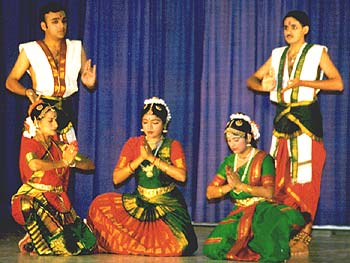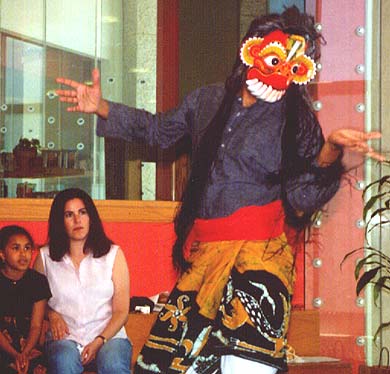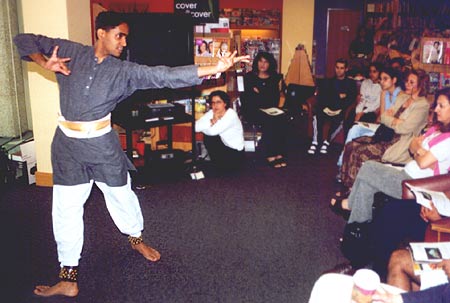| Dance | U.S.A. | ||||||||||||||||||||||||||||||||||||||||||||||
BAFA © 2010. All material here is copyrighted. See conditions above. |
Vasu Mohan theater, dance, U.S.A. |
|
"Whither the hand goes, the glance follows,
Whither the glances lead, the mind follows, Whither the mind goes, there the mood follows Whither the mood goes, there is "rasa" born." -Abhinaya Darpana
|
 Natyotpatti (The genesis of dance), 1998, a piece where chants from ancient Hindu scriptures are used to depict their salient features and show how dance is thought to have evolved from them. |
most often is Bharata Natyam.
Bharata Natyam is a dance style that traces is origins back to the dances performed in Indian temples as part of ritual worship. Today it is widely performed on stages across India and the world. It is both a window into the values, traditions and philosophy of Indian culture and a media of expression of the new ideas that have come into being as the contact and interaction of people from various parts of the world and India increases.
 Natyotpatti, (The genesis of dance), 1998.
|
My introduction to Bharata Natyam began as a toddler when my grandmother
took me to watch rehearsals at the Kalakshetra Academy of Dance in Madras,
India.
I watched and internalized the beauty of dance performed by both men and women in that prestigious dance school. My mother grew up in Kalakshetra and I would often listen with rapt attention to her stories of growing up in that community of artistes and educators. |
|
The next stage of my training began when my sister started dance lessons. I
would try steps, picking up little nuances and details of the dance classes
I watched. There was still a taboo of men performing classical dance in my
family and to a large extent in Indian society.
My family lived in Sri Lanka till I was 10 and moved to India due to the ongoing civil war. |

Asmita choreographed by Mudra in 1996, is about equality of women and men and the challenges to achieving it, combining music and dance from different parts of India and poetry by female poets and visionaries from around the world. Asmita means Nameless (in the feminine form) in Sanskrit. |

Sri Lankan mask dance being performed at Borders book store in the DC Metro area, 2001.
|
I joined a middle school in Kalakshetra in Madras and it
was decided that my sister would continue learning dance there and I was to
learn to play the mridamgam (a percussion instrument used in south Indian
classical music).
|
For a show in college she and I decided to perform a piece
that a dance teacher had choreographed for us.
|

Pupil of the eye, 1998, dance movement with spoken parts, is on discrimination based on color. It's subtitled 'conversations of the color black with its creator' and draws from Hindu, Islamic and Bahá'í scriptures and traditions. Here the personification of the color black is in conversation with God. |

Bharata Natyam being performed at Borders book store in the DC Metro area, 2001.
|
We began experimenting with new ideas and techniques with a
consciousness of social justice. Often the principles and Writings of the
Bahá'í Faith are used in our productions and I also continue to perform solo
in many venues. |
| email: vasumohan{AT}hotmail.com |
|
Arts Dialogue, Dintel 20, NL 7333 MC, Apeldoorn, The Netherlands email: bafa@bahai-library.com |